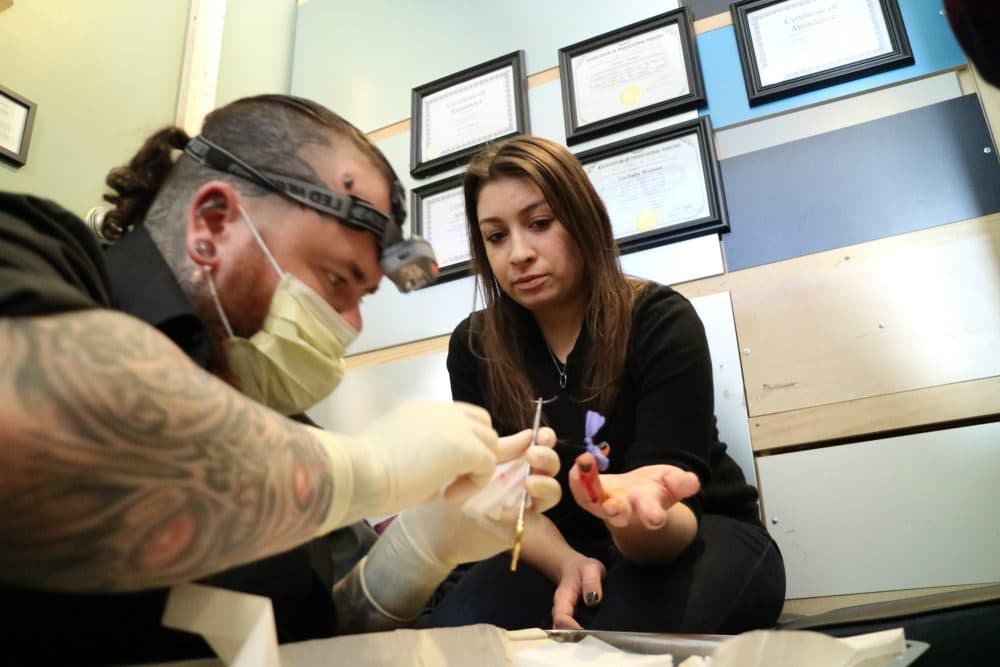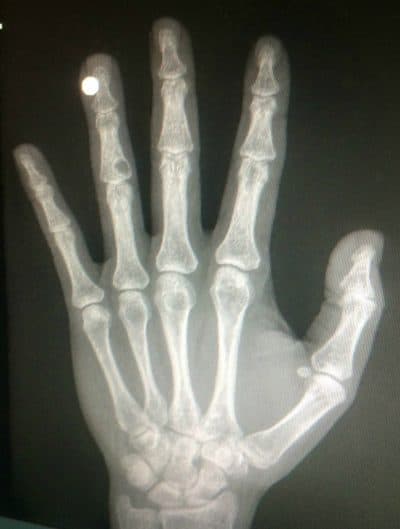Advertisement
Why I Had A Magnet Implanted In My Finger

My journey to becoming a cyborg began in the basement of an unassuming brown house, not far from the Pittsburgh airport. In February, I spent a day in the makeshift laboratory and headquarters of biohacking collective Grindhouse Wetware. Here, engineer Tim Cannon leads a crew of youngish technologists who call themselves “grinders.”
Grinders are the maker-punks of the emerging Transhumanist movement. They are self-identified citizen scientists with a DIY ethos who are attempting to push the limits of human enhancement -- in this case, by implanting electronics (such as chips, magnets, small computers and LED lights) into their bodies.
I had come to get a small magnet surgically implanted into the ring finger of my left hand. I had read about magnets and was writing a story about grinder culture. I felt I couldn’t fully understand the sensation of the magnet unless I got one myself.
Although there is no official count of people who have implants, DIY surgery is far from mainstream. But it’s not exactly in the shadows, either. Grindhouse Wetware is one of a handful of American biohacking collectives, and similar groups have also cropped up in Europe and Asia. Conservative estimates by biohackers put the number of people with implants in the thousands — maybe as many as 10,000 — globally.
So while kids aren’t lining up at Hot Topic to get implanted, the trend is catching fire.

The implant was an experiment I had hoped to participate in for a long time, something I had been curious about since I first heard that a magnet could give a human a sixth sense -- the ability to physically feel electromagnetism.
I decided I had to get it done myself if I ever hoped to adequately describe it to others. I flew to Pittsburgh to meet Cannon and his team, including Zack Watson, a body modification specialist who performed the implant in his studio on Pittsburgh’s South Side.
Implants are dangerous. They are not approved by any medical authority, and doctors refuse to perform implants because, unlike pacemakers or artificial hips, implanted electronics violate the Hippocratic Oath -- grinders implant magnets for the sake of augmentation and enhancement. They have no proven health benefits and could result in unnecessary harm. They are also widely illegal in many states, including in Massachusetts.
Better ethical regulations would keep people safer, and biohackers agree. They believe regulation would reduce risk by requiring medical professionals to perform medical procedures, such as implantation.
Advertisement
Dr. Deb Chachra, a biomedical engineering professor at Olin College, has been an avid observer of grinder culture since the 1990s, when tattoos, piercings and body modification became mainstream fascinations. In an essay on her blog, Chachra compared the issues around implant regulation to those surrounding cosmetic breast augmentation in the 1980s. Initially, cosmetic implants were forbidden because they served no medical purpose and could be dangerous.
Feeling the inner workings of my steering wheel, my laptop and my microwave was a revelation.
Intrauterine devices (IUDs), too, are legal surgical implants with the ability to affect human biology. Essays by technology journalists Quinn Norton and Rose Eveleth point to the cyborgian nature of implanted birth control methods and argue that chips and magnets should be treated no differently.
I loved the magnet. It was incredible to feel electricity around me. The “zap” and “buzz” I felt in the nerves of my hand was a high. I became elated whenever I came into contact with a machine and felt my magnet respond. I loved freaking people out by picking up safety pins just by running my hand over them, and feeling the inner workings of my steering wheel, my laptop and my microwave was a revelation.
I emailed or talked to Cannon and Watson daily, giving updates on the magnet’s status, sending photos and asking about the inflammation, colors, and feelings of my finger, attempting to document every moment of life with an implant.
While many citizen scientists do keep meticulous records and publish many of their logs online, there is a dearth of information from the many hundreds of individuals who have implants and don’t track their reactions. Collecting data on the experience of implants only help make a case for legalization, and grinders should encourage each other to document what materials and techniques work best, how and why.
Ultimately, someone will come up with a way to utilize electronic and magnetic implants for reasons beyond the desire to feel a sixth sense.
It’s not hard to imagine that implants could one day serve an important purpose and become ubiquitous. Grindhouse Wetware is already experimenting with ways to store and transmit data through magnets, and have a handful of other projects on deck.
My body painfully rejected my magnet, and after only 12 days, an emergency room doctor removed it. It had become deeply infected, although I don’t know why. I assume it was my fault — Did I bump my finger? Did I not keep the area clean enough? — and not a problem with the magnet.
I was devastated.
When people ask me why I got the magnet, I say the “why” isn’t the important question. What people should be asking me is, “Why was it good, even though it failed?”
When it comes to experimentation, sometimes deep insights come from small failures, leading to great leaps in innovation that could save lives and help others. And despite my sadly failed magnet, I am happy to contribute to that lofty goal.
